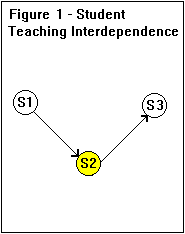 Educational Systems Theory
Educational Systems Theory Educational Systems Theory
Educational Systems Theory


Example 2 - Another example of interdependence takes place in a classroom or study area with three students. Each student has an area of mathematics that they understand very well. The three students are studying together for an upcoming mathematics test. The affect relation is "guides the learning of another." Each student teaches the other two students about their area of mathematics expertise. Each student represents a component which has a channel to and from them and thus represents interdependence. A graphic representation might look like Figure 2. S1, S2, and S3 each represent a student. S1 has expertise in addition, S2 has expertise in subtaction, and S3 has expertise in multiplication.
102. If educational system interdependence increases, then feedin increases.
 Go to SIGGS Home Page.
Go to SIGGS Home Page.